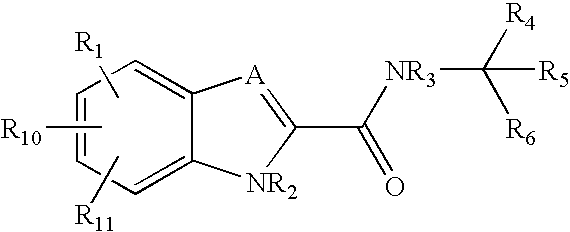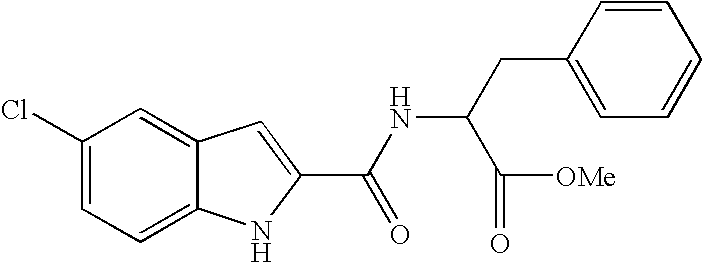Pyrazole compounds and their use as antidiabetes agents
a technology of pyrazole and pyrazole, which is applied in the direction of drug compositions, biocide, metabolic disorders, etc., can solve the problems of hyperglycemia and glycosuria, ketonemia and acidosis, diabetic coma, etc., and achieve superior oral absorption and metabolic stability, and the effect of reducing the risk of side effects
- Summary
- Abstract
- Description
- Claims
- Application Information
AI Technical Summary
Benefits of technology
Problems solved by technology
Method used
Image
Examples
reference example 1
Preparation of 5-(2-chloro-4,5-difluoro-benzoylamino)-1H-pyrazole-3-carboxylic acid imidazolide and benzotriazol-1-yl-5-(2-chloro-4,5-difluoro-benzoylamino)-1H-pyrazole-3-carboxylate
Step 1: Preparation of 2-chloro-4,5-difluorobenzoyl chloride
[2179]
[2180] To a solution of 2-chloro-4,5-difluorobenzoic acid (508.20 g) in toluene (250 mL) was added N,N-dimethylformamide (0.2 mL), and the resulting mixture was heated to 65° C., followed by addition of thionyl chloride (230 mL) dropwise. After stirring for 3 hours at 120° C., the reaction solution was concentrated under reduced pressure, and the resulting residue was distilled under reduced pressure (bp of 51 to 64° C. (130 to 140 Pa)) to obtain the title compound (534.45 g) as an oil.
Step 2: Preparation of Ethyl 5-nitro-3-pyrazolecarboxylate
[2181]
[2182] To a solution of 5-nitro-3-pyrazole carboxylic acid (310.24 g) in ethanol (3 L) was added methanesulfonic acid (143 mL), and the resulting mixture was stirred overnight at 94° C. Afte...
reference example 2
Preparation of 3-aminomethyl-2-isopropoxy-pyridine
Step 1: Preparation of 2-isopropoxy-nicotinamide
[2195]
[2196] To a solution of 2-chloronicotinamide (1.50 g) in 2-propanol (45 m) was added 60% sodium hydride (640 mg). After stirring for 2 days at 100° C., the resulting mixture was added to water (50 mL), and extracted with ethyl acetate (80 mL). The organic layer was washed with 1 N hydrochloric acid, dried over anhydrous sodium sulfate, and then concentrated. The resulting residue was purified by silica gel column chromatography (n-hexane-ethyl acetate, 5:1□2:1) to obtain the title compound (1.64 g) as colorless crystals.
Step 2: Preparation of 2-isopropoxy-nicotinonitrile
[2197]
[2198] To a solution of 2-isopropoxy-nicotinamide (1.64 g) in chloroform (16 mL) was added triethylamine (2.8 mL). The resulting solution was added trichloroacetyl chloride (1.1 mL) dropwise with ice-bath cooling. After stirring overnight at room temperature, saturated aqueous sodium hydrogencarbonate was...
example 1-1
Preparation of 5-(2-chloro-4,5-difluoro-benzoylamino)-1H-pyrazole-3-carboxylic acid (pyridin-3-ylmethyl)-amide
[2203]
[2204] To a suspension of 5-(2-chloro-4,5-difluoro-benzoylamino)-1H-pyrazole-3-carboxylic acid imidazolide (6.00 g) obtained in Step 7 of Reference Example 1 in N,N-dimethylformamide (50 mL) was added 3-picolylamine (1.72 mL) with ice-bath cooling. After stirring overnight at room temperature, water (25 mL) and saturated aqueous sodium hydrogencarbonate (50 mL) were added to the resulting reaction mixture. The formed solid was filtered to obtain the title compound (4.49 g) as a white solid.
PUM
| Property | Measurement | Unit |
|---|---|---|
| weight | aaaaa | aaaaa |
| temperature | aaaaa | aaaaa |
| temperature | aaaaa | aaaaa |
Abstract
Description
Claims
Application Information
 Login to View More
Login to View More - R&D
- Intellectual Property
- Life Sciences
- Materials
- Tech Scout
- Unparalleled Data Quality
- Higher Quality Content
- 60% Fewer Hallucinations
Browse by: Latest US Patents, China's latest patents, Technical Efficacy Thesaurus, Application Domain, Technology Topic, Popular Technical Reports.
© 2025 PatSnap. All rights reserved.Legal|Privacy policy|Modern Slavery Act Transparency Statement|Sitemap|About US| Contact US: help@patsnap.com



